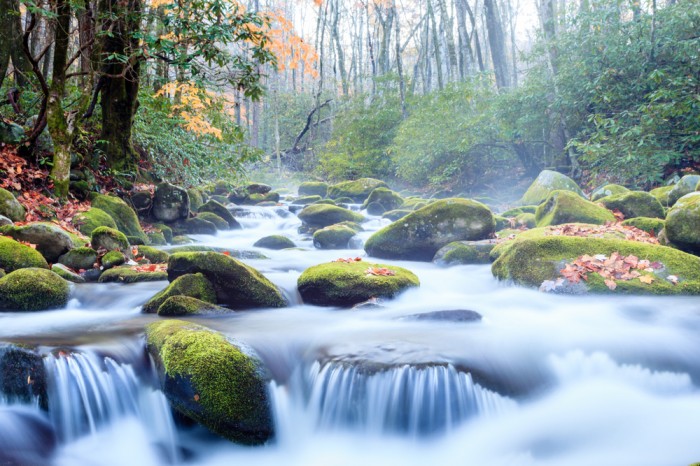Travel: Great Smoky Mountains National Park

Spanning the southern states of North Carolina and Tennessee, Great Smoky Mountains National Park is the most-visited park in the nation. While its roads will soon be teeming with leaf peepers, the beauty of this national park is that most visitors enjoy it from the comfort of their own vehicle. That leaves the trails less congested for the more adventurous among us. Here’s a rundown of how to see Great Smoky Mountains National Park in three days, including the best ways to get off the beaten path and onto the trails less traveled.
Day One: Wheels do help to cover some of the park’s half a million acres so cruise Cades Cove. Once a Cherokee hunting ground and later a bustling mountain community, the low-lying area offers a stunning perspective on Smoky Mountain peaks. If you have a bike in tow (or are game to rent one) then check out the 11-mile cycling loop here—cars are prohibited from sunrise to 10am Wednesdays and Saturdays in the summer.
Next, drive South up Newfound Gap Road, find a trailhead, and go rambling. Camp tonight or, if you planned a year ahead, end your evening 5.5 miles from the Alum Cave Trailhead at the popular, hike-in LeConte Lodge (rates, including dinner and breakfast, start at $126).
Day Two: If you stay at the Lodge, set your alarm to take a quick hike to Myrtle Point for sunrise. If you camped elsewhere, take a long stroll down the short Cove Hardwood Nature Trail—starting at Chimney Picnic Area, you’ll find curbside service to rare and surprisingly unexploited East Coast old-growth trees.
Head to the eastern corner of the park, Cataloochee, through the Cherokee Indian Reservation, populated by descendents of those who eluded the Trail of Tears. Just outside of the reservation take Big Cove Road to the stunning southern cascade that is Mingo Falls.
If you’re feeling spendy, lay your head down at The Swag Mountaintop Inn, the most luxurious “rustic” lodge imaginable (rates, including dinner, breakfast, and packed lunch, start at $495).
Day Three: Relax if you must but try to make it to Cataloochee early—your best chance of spotting eastern elk (reintroduced in 2001). If you’ve still got legs hike the Boogerman Trail, known for its history, old-growth forests, and wildflowers.
Great Smoky Mountains By the Season:
• October: Fall Foliage (and the crowds it draws)
• Mid- to Late-April: Peak Wildflower Season
• Early June: Synchronous Fireflies (yes, this happens, and it is incredible)
• Early to Late June: Rhododendron Blooms
Kamagra oral jelly Online something to buy the most convenient way. He doesn’t demand from you any actions except how to visit the website. And in separate with goods necessary to you to put the end. To specify your address and to wait for the supplier to whom you will give money.


November 21st, 2015 at 2:17 pm
[…] Link to story on Women’s Movement. […]